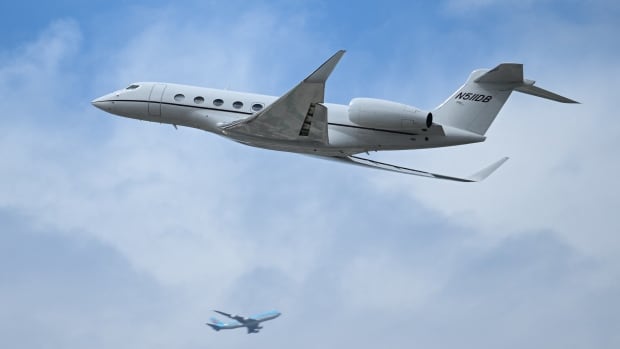For most of us, air travel is a rare event that can be accompanied by long lines, long waits and lost luggage. But not so for those rich enough to fly on private jets.
Instead, those millionaires and billionaires can jet-set around the world with ease, and with little thought to their carbon footprint while doing so.
When it comes to aviation in general — something only a small share of the world’s population takes part in — it contributes roughly 2.5 per cent of all CO2 emissions and has thus far contributed to roughly four per cent of global warming.
But just how much CO2 emissions are these private jets emitting?
Authors of a new study published in the journal Nature Communications Earth & Environment tried to quantify that number.
They found that some people who use private jets could be producing roughly 500 times more CO2 in a year than the average person, globally.
Patterns of aviation 2023
The study’s authors used a flight tracking system called the ADS-B Exchange, which is used by flight tracking apps like FlightAware and Flightradar24, to gather data from 2019 to 2023 on nearly 26,000 private aircraft, and linked that to 72 different aircraft models and their average fuel consumption.
They found that private flights contributed at least 15.6 metric tonnes of CO2 (MtCO2) in 2023. That equated to roughly 3.6 tonnes of CO2 for each flight — around the emissions of driving a passenger vehicle some 14,000 km from Vancouver to St. John’s and back.
And 47.4 per cent of the flights were shorter than 500 km, with 4.7 per cent being fewer than 50 kilometres.
As well, in the period of 2019-2023, emissions increased by 46 per cent.
They also tracked flights for specific events in 2023, such as the Super Bowl in Glendale, Arizona, the World Economic Forum in Davos, Switzerland, the climate Conference of Parties (COP28) in Dubai, and the Cannes film festival in France.
The Super Bowl, the biggest sporting event in the U.S., draws people on private jets from all over the country and beyond, as the graphic illustrates.
For COP 28, private jets were used to fly into Dubai from all over the world, which may seem like a contradiction for a conference that is trying to reduce greenhouse gas emissions, the driver of climate change. But Stefan Gössling, lead author of the new study and a professor at Linnaeus University’s school of business and economics in Sweden, said it may not necessarily be government, think tanks or climate non-governmental organizations.
“I’m presuming that most of these smaller aircraft are then business people coming to these events,” he said. “We do know that perhaps the COP is no longer a purely political event. It’s a negotiation with business leaders, oil interests.”

Gössling said that overall, these private flights by the wealthy is indicative of something else.
“I think the overall picture here is that that we look into a world that exists outside our world … that is very luxurious, that is characterized by maximum convenience, and that also is characterized by disregard of climate change,” he said.

Oxfam International released in October that looked at 50 of the richest people in the world and their carbon footprint. In it, they found that these people release more carbon through private jets, yachts and investments in a year than the average person does in their entire life.
“If everybody in the world travelled like the billionaires that were covered in our Oxfam study, we would overshoot the carbon budget within two days,” said Ian Thomson, manager of policy and advocacy for Oxfam Canada. “So it’s just not a sustainable form of transportation, and we have to do more to curb private jet travel.”
Interestingly, many of those jets attended similar events, though there’s no way of determining who, since only the planes themselves were tracked.
The issue, both Thomson and Gössling said, is inequality.
In the Oxfam study, Elon Musk produces roughly 5,497 tonnes of CO2 per year, equivalent to 834 years’ worth of emissions for the average person, or 5,437 years’ worth for someone in the poorest 50 per cent.
It also found that, for someone flying on a commercial jet in economy class, they pay a 43 per cent air tax (relative to ticket prices), while flying in business class it’s 23 per cent. But for private flights? It’s only a two per cent tax.
“We know that the the richest one per cent of people are responsible for half of all air travel emissions in the world. So it’s really going after this rich polluter elite that is going to help us in curbing air travel emissions,” Thomson said.
In the end, Gössling’s study found that, in 2023, the total direct emissions from private jets of 15.6 Mt CO2 was equivalent to roughly 1.8 per cent of the total emissions produced by commercial aviation.
“I think one important message here is probably that this is a really, really carbon intensive activity. Carbon emissions are a cost. We do know that climate change, when it hits, is costly,” Gössling said.
“We know what that price tag is, and I think it would be very important that the wealthy paid for the cost of the climate damage that they are doing, because otherwise it will be falling on the poor, which I think most people will not think is is a fair approach to dealing with the problem.”


